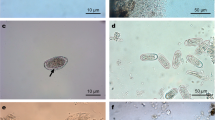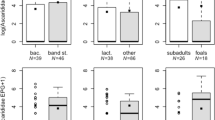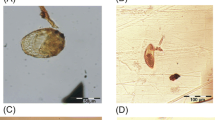Abstract
Investigation of endo-macroparasite infections in living animals relies mostly on indirect methods aimed to detect parasite eggs in hosts’ faeces. However, faecal flotation does not provide quantitative information on parasite loads, whereas faecal egg count (FEC) techniques may not give reliable estimates of parasite intensity, since egg production may be affected by density-dependent effects on helminth fecundity. We addressed this issue using Eastern grey squirrels (Sciurus carolinensis) and their gastrointestinal nematode Strongyloides robustus to assess the performance of coprological techniques and to investigate factors affecting parasite fecundity. We compared results of gut examination, flotation and McMaster FECs in 65 culled grey squirrels. Sensitivity and specificity of flotation were 81.2 % (Confidence Interval, CI 54.3–95.9 %) and 85.7 % (CI 72.7–94.1 %), respectively, resulting in low positive predictive values when infection prevalence is low. Individual parasite fecundity (no. of eggs/adult female worm) was negatively affected by S. robustus intensity, leading to a non-linear relationship between parasite load and eggs/gram of faeces (EPG). As a consequence, whereas flotation may be a valid method to perform the first screening of infection status, FECs are not a reliable method to estimate S. robustus intensity, since diverse values of EPG may correspond to the same number of parasites. Neither the amount of analysed faeces nor the season had any effect on EPG, indicating that the observed reduction in helminth fecundity is likely caused exclusively by density-dependent processes such as competition among worms or host immune response.


Similar content being viewed by others
References
Anderson RM, Schad GA (1985) Hookworm burdens and faecal egg counts: an analysis of the biological basis of variation. Trans R Soc Trop Med Hyg 79:812–825. doi:10.1016/0035-9203(85)90128-2
Brown ED, Macdonald DW, Tew TE, Todd IA (1994) Rhythmicity of egg production by Heligmosomoides polygyrus in wild wood mice, Apodemus sylvaticus. J Helminthol 68:105–108. doi:10.1017/S0022149X00013602
Christensen CM, Barnes EH, Nansen P, Roepstorff A, Slotved H-C (1995) Experimental Oesophagostomum dentatum infection in the pig: worm populations resulting from single infections with three doses of larvae. Int J Parasitol 25:1491–1498. doi:10.1016/0020-7519(95)00085-2
Close B, Banister K, Baumans V, Bernoth E-M, Bromage N, Bunyan J, Erhardt W, Flecknell P, Gregory N, Hackbarth H, Morton D, Warwick C (1996) Recommendations for euthanasia of experimental animals: part 1. Lab Anim 30:293–316. doi:10.1258/002367796780739871
Close B, Banister K, Baumans V, Bernoth E-M, Bromage N, Bunyan J, Erhardt W, Flecknell P, Gregory N, Hackbarth H, Morton D, Warwick C (1997) Recommendations for euthanasia of experimental animals: part 2. Lab Anim 31:1–32. doi:10.1258/002367797780600297
Davidson WR (1976) Endoparasites of selected populations of gray squirrels (Sciurus carolinensis) in the southeastern United States. Proc Helminthol Soc Wash 43:211–216
Dezfuli BS, Volponi S, Beltrami I, Poulin R (2002) Intra-and interspecific density-dependent effects on growth in helminth parasites of the cormorant, Phalacrocorax carbo sinensis. Parasitology 124:537–544
Dunn A, Keymer A (1986) Factors affecting the reliability of the McMaster technique. J Helminthol 60:260–262. doi:10.1017/S0022149X00008464
Elkins DB, Sithithaworn P, Haswell-Elkins M, Kaewkes S, Awacharagan P, Wongratanacheewin S (1991) Opisthorchis viverrini: relationships between egg counts, worms recovered and antibody levels within an endemic community in Northeast Thailand. Parasitology 102:283–288. doi:10.1017/S0031182000062600
Gillespie TR (2006) Noninvasive assessment of gastrointestinal parasite infections in free-ranging primates. Int J Primatol 27:1129–1143. doi:10.1007/s10764-006-9064-x
Hudson PJ, Dobson AP (1995) Macroparasites: observed patterns. In: Grenfell BT, Dobson AP (eds) Ecology of infectious diseases in natural populations. Cambridge University Press, Cambridge, pp 144–176
Hudson PJ, Dobson AP (1997) Transmission dynamics and host-parasite interactions of Trichostrongylus tenuis in red grouse (Lagopus lagopus scoticus). J Parasitol 83:194. doi:10.2307/3284438
Irvine RJ, Stien A, Dallas JF, Halvorsen O, Langvatn R, Albon SD (2001) Contrasting regulation of fecundity in two abomasal nematodes of Svalbard reindeer (Rangifer tarandus platyrhynchus). Parasitology 122:673–681. doi:10.1017/S0031182001007818
Keymer A (1982) Density-dependent mechanisms in the regulation of intestinal helminth populations. Parasitology 84:573–587. doi:10.1017/S0031182000052847
Leary SL, Underwood W, Anthony R, Cartner S, Corey D, Grandin T, Greenacre C, Gwaltney-Brant S, McCrackin M, Meyer R, Miller D, Shearer J, Yanong R (2013) AVMA guidelines for the euthanasia of animals. https://www.avma.org/KB/Policies/Documents/euthanasia.pdf
Lowrie FM, Behnke JM, Barnard CJ (2004) Density-dependent effects on the survival and growth of the rodent stomach worm Protospirura muricola in laboratory mice. J Helminthol 78:121–128. doi:10.1079/JOH2003230
MAFF (1977) Manual of veterinary parasitological laboratory techniques. Her Majesty’s Stationary Office, London
Michael E, Bundy DAP (1989) Density dependence in establishment, growth and worm fecundity in intestinal helminthiasis: the population biology of Trichuris muris (Nematoda) infection in CBA/Ca mice. Parasitology 98:451–458. doi:10.1017/S0031182000061540
Paterson S, Viney ME (2002) Host immune responses are necessary for density dependence in nematode infections. Parasitology 125:283–292
Perkins SE, Cattadori IM, Tagliapietra V, Rizzoli A, Hudson PJ (2003) Empirical evidence for key hosts in persistence of a tick-borne disease. Int J Parasitol 33:909–917. doi:10.1016/S0020-7519(03)00128-0
Poulin R (1997) Population abundance and sex ratio in dioecious helminth parasites. Oecologia 111:375–380. doi:10.1007/s004420050248
Quinnell RJ, Medley GF, Keymer AE (1990) The regulation of gastrointestinal helminth populations. Philos Trans R Soc Lond B Biol Sci 330:191–201. doi:10.1098/rstb.1990.0192
Core Team R (2013) R: a language and environment for statistical computing. R Foundation for Statistical Computing, Vienna
Rausch R, Tiner JD (1948) Studies on the parasitic helminths of the North Central States. I. Helminths of Sciuridae. Am Midl Nat 39:728. doi:10.2307/2421532
Roepstorff A, Bjørn H, Nansen P, Barnes EH, Christensen CM (1996) Experimental Oesophagostomum dentatum infections in the pig: worm populations resulting from trickle infections with three dose levels of larvae. Int J Parasitol 26:399–408. doi:10.1016/0020-7519(96)00006-9
Romeo C, Pisanu B, Ferrari N, Basset F, Tillon L, Wauters LA, Martinoli A, Saino N, Chapuis J-L (2013) Macroparasite community of the Eurasian red squirrel (Sciurus vulgaris): poor species richness and diversity. Parasitol Res 112:3527–3536. doi:10.1007/s00436-013-3535-8
Romeo C, Wauters LA, Ferrari N, Lanfranchi P, Martinoli A, Pisanu B, Preatoni D, Saino N (2014) Macroparasite fauna of alien grey squirrels (Sciurus carolinensis): composition, variability and implications for native species. PLoS One 9:e88002. doi:10.1371/journal.pone.0088002
Seivwright LJ, Redpath SM, Mougeot F, Watt L, Hudson PJ (2004) Faecal egg counts provide a reliable measure of Trichostrongylus tenuis intensities in free-living red grouse Lagopus lagopus scoticus. J Helminthol 78:69–76. doi:10.1079/JOH2003220
Shaw JL, Moss R (1989) The role of parasite fecundity and longevity in the success of Trichostrongylus tenuis in low density red grouse populations. Parasitology 99:253–258. doi:10.1017/S0031182000058704
Sinniah B (1982) Daily egg production of Ascaris lumbricoides: the distribution of eggs in the faeces and the variability of egg counts. Parasitology 84:167–175. doi:10.1017/S0031182000051763
Sithithaworn P, Tesana S, Pipitgool V, Kaewkes S, Pairojkul C, Thaiklar K (1991) Relationship between faecal egg count and worm burden of Opisthorchis viverrini in human autopsy cases. Parasitology 102:277–281. doi:10.1017/S0031182000062594
Smith G, Grenfell BT, Anderson RM (1987) The regulation of Ostertagia ostertagi populations in calves: density-dependent control of fecundity. Parasitology 95:373–388. doi:10.1017/S0031182000057814
Thrusfield M (2013) Veterinary epidemiology. Wiley, Oxford
Tompkins DM, Begon M (1999) Parasites can regulate wildlife populations. Parasitol Today 15:311–313. doi:10.1016/S0169-4758(99)01484-2
Tompkins DM, Hudson PJ (1999) Regulation of nematode fecundity in the ring-necked pheasant (Phasianus colchicus): not just density dependence. Parasitology 118:417–423
Wilson K, Bjørnstad ON, Dobson AP, Merler S, Poglayen G, Randolph SE, Read AF, Skorping A (2002) Heterogeneities in macroparasite infections: patterns and processes. In: Hudson PJ, Rizzoli A, Grenfell BT, Heesterbeek H, Dobson AP (eds) The ecology of wildlife diseases. Oxford University Press, Oxford, pp 6–44
Acknowledgments
We would like to thank Cuneo Province and private estates owners for allowing field collection. Many thanks also to Leila Luise and Sara Vedovato for their assistance with laboratory analysis.
Ethical standards
Sampling of grey squirrels was carried out with authorizations by Cuneo Province (Permit No. 473, 12 May 2011) and the Italian Institute for Environmental Protection and Research (ISPRA). All sampling protocols were chosen to minimise animal stress and suffering. Squirrels were euthanised immediately after capture following EC and AVMA guidelines (Close et al. 1996, 1997; Leary et al. 2013).
Author information
Authors and Affiliations
Corresponding author
Rights and permissions
About this article
Cite this article
Romeo, C., Wauters, L.A., Cauchie, S. et al. Faecal egg counts from field experiment reveal density dependence in helminth fecundity: Strongyloides robustus infecting grey squirrels (Sciurus carolinensis). Parasitol Res 113, 3403–3408 (2014). https://doi.org/10.1007/s00436-014-4005-7
Received:
Accepted:
Published:
Issue Date:
DOI: https://doi.org/10.1007/s00436-014-4005-7




